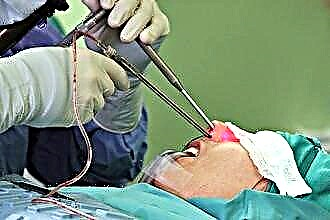Blowing out the ears according to Politzer is an otolaryngological procedure that is used to determine the degree of patency of the Eustachian tube or its ventilation. The physiotherapeutic method is used to treat the consequences of chronic otitis media, eustachitis and other ear pathologies, accompanied by swelling of the mucous membrane of the auditory canals.
In the process of blowing, air is pumped into the ear cavity using a special pear, the tip of which is inserted into the patient's nostril. The course application of the treatment procedure helps to increase the inner diameter in the auditory canal and restore its ventilation function. Physiotherapy is carried out mainly on an outpatient basis under the supervision of an otolaryngologist.
Purpose of the procedure

The normalization of the drainage and ventilation function of the Eustachian tube occurs due to the fact that during articulation the muscles of the soft palate contract, as a result of which it rises up. At this point, the nasopharynx and oropharynx are separated from each other, which leads to the opening of the mouth of the auditory tube. Thus, air enters the ear cavity through the auditory canal, due to which the external and internal pressure on the eardrum is equalized.
With the development of infectious diseases in the nasopharynx or the organ of hearing, inflammation of the mucous epithelium is observed. This inevitably leads to tissue edema and impaired patency in the auditory canal. Eustachian tube dysfunction results in negative pressure in the middle ear. As a result, the ear membrane is pulled into the ear by the relatively high atmospheric pressure.
The ear blowing procedure helps to reduce the difference in external and internal pressure on the ear membrane.
That is why it is prescribed in the following cases:
- acute eustacheitis;
- autophony;
- aerootitis;
- otitis media;
- conductive hearing loss;
- rehabilitation after tympanoplasty.
Important! In case of acute inflammation of the nasopharynx, the effectiveness of the procedure will be minimal. Due to the swelling of the mucous tissues, a minimum amount of air will get into the mouth of the ear canal.

Preparing for the procedure
Invasive intervention is carried out by forcing air into the auditory tube through the nasal passage. To facilitate the passage of air masses, before the procedure, you need to do the following:
- to clear the nasal passages of mucous secretions;
- drip vasoconstrictor drugs to reduce swelling of the mucous membrane;
- disinfect the nasopharynx with saline to prevent pathogens from entering the middle ear cavity;
- sterilize the tip inserted into the nostril with an alcohol solution.
Important! Do not purge in the presence of mental abnormalities and persons with epilepsy.
It should be noted that blowing the auditory tubes according to the Politzer in preschool children requires additional preparation. To avoid injury to the soft tissues of the nasopharynx during an invasive intervention, it is advisable to give the child soothing medications based on herbal ingredients.
Carrying out the procedure
Physiotherapy manipulations are carried out using special equipment consisting of a rubber bulb, a thin tube and an olive. The tip, which is inserted into the patient's nostril, is pressed firmly against the wing of the nose. In this case, the second nostril is simply pressed against the nasal septum to create an airtight environment.
During a physiotherapy session, the specialist asks the patient to articulate the word "steamer". At the moment of pronouncing the last syllable, when the soft palate rises slightly, the otolaryngologist presses the pear and the air stream rushes into the auditory canal. With a successful outcome of the procedure, the pressure in the tympanic cavity is normalized, and the inner diameter in the ear canal increases. Due to this, the outflow of serous effusion from the middle ear improves, thereby eliminating congestion, a feeling of fullness and heaviness in the head.
 In 85% of cases, hearing improvement occurs after 3-4 invasive procedures. In some cases, the effect after blowing is unstable and disappears within 3 hours. To restore the normal function of the Eustachian tube, the specialist recommends purging for 2 weeks every other day.
In 85% of cases, hearing improvement occurs after 3-4 invasive procedures. In some cases, the effect after blowing is unstable and disappears within 3 hours. To restore the normal function of the Eustachian tube, the specialist recommends purging for 2 weeks every other day.
Evaluation of results
When carrying out a diagnostic and treatment procedure, it is possible to determine the degree of patency of the ear canals and the presence of serous exudate in the tympanic cavity. During the manipulations, the ear of the patient and the otolaryngologist are connected with a stethoscope, through which the specialist audibly evaluates the sound effects that occur when blowing. How are the results evaluated?
- with the unhindered passage of air through the auditory canal, a characteristic hiss is heard;
- if the air flow on its way meets an obstacle, this is signaled by discrete crackling sounds;
- in the presence of serous effusion in the ear cavity, the patient and the doctor will hear a sound that resembles the bursting of bubbles;
- the absence of any sounds indicates an obstruction of the Eustachian tube.
Depending on the results of a subjective analysis, a specialist can prescribe a medication course of treatment with antiphlogistic, anti-edematous, mucolytic and analgesic drugs.
Complications
Is it possible to blow the ears over the Politzer at home? According to experts, the invasive procedure should be carried out under the supervision of an otolaryngologist. But in the absence of the possibility of outpatient treatment, you can undergo physiotherapy on your own. It is important to take into account the precautions and contraindications for the procedure.
Ignoring safety precautions can cause complications, which include:
- bleeding from the ear;
- development of purulent otitis media;
- rupture of the ear membrane;
- middle ear contusion;
- hearing impairment;
- emphysema of the periopharyngeal tissue.
To avoid negative consequences, it is necessary to carry out medical manipulations under the supervision of a qualified specialist.
Blowing at home
You can master the principle of carrying out a physiotherapy procedure on your own, but only with an assistant. Blowing out the auditory tubes according to the Politzer at home is carried out using a rubber bulb with a tube and a plastic tip in the shape of an olive.
Technique of the procedure:
- the assistant should disinfect the plastic tip with alcohol and insert it into the patient's nostril;
- with his left hand, the assistant presses the open nostril against the nasal septum and asks the patient to pronounce the word "steamer" by syllables;
- at the moment of pronouncing the last syllable, it is necessary to squeeze the rubber bulb to ensure that air enters the Eustachian tube.
Important! Do not push too hard on the bulb as this can cause high pressure in the middle ear and rupture of the ear membrane.
With successful blowing, the patient will hear a clap in one or both ears, signaling the alignment of the ear membrane, which occurs due to the elimination of the difference in external and internal pressure.



